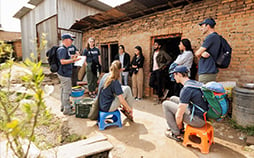Researching the Effects of Air Pollution in Nepal
An interdisciplinary BYU research team traveled to Nepal to measure brick workers’ exposure to pollutants and to assess their respiratory health.
Change people's lives at home and around the world
March 2023
At an excavation site in northern Mexico, BYU archaeology students and professors recently discovered artifacts that have been buried for 1,000 years, including pottery sherds, hammer stones, maize kernels and — intriguing at a location 250 miles inland — a shell bead from the Pacific Ocean.
The site known as Casas Grandes, also called Paquimé, was a large ancient city that peaked between 1200 and 1400 A.D.
The team has employed some advanced technology to document their discoveries, including robotic surveying instruments that map artifacts with millimeter-level precision, survey-grade GPS and unmanned aerial systems that take images of the site from the sky. Managing this technology is an important part of the students’ archaeological training.
Immersion in the culture — from collaborating with fellow archaeology students at the National School of Anthropology and History in northern Mexico on the excavation, to experiencing the food and language of the area — also adds depth to the students’ training that isn’t attainable on campus.
“I can sit in a classroom and talk about what it’s like to move dirt, but there is nothing better for a student than to find their first arrowhead or to pull out a piece of pottery with designs on it we’ve never seen before,” Searcy said. “It’s one of the pinnacles of experiential learning to be in the field with students and watch them make discoveries.”

An interdisciplinary BYU research team traveled to Nepal to measure brick workers’ exposure to pollutants and to assess their respiratory health.

Video:BYU professors and students are gathering stories from survivors of life under the Khmer Rouge regime.

Emily Flake was one of a group of health and wellness students that traveled to Ikaria, Greece, to learn about eating, living, and cooking the Mediterranean way.